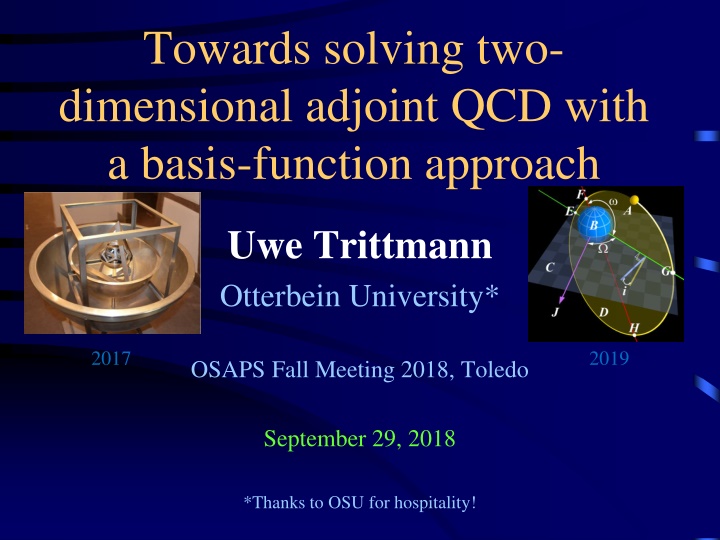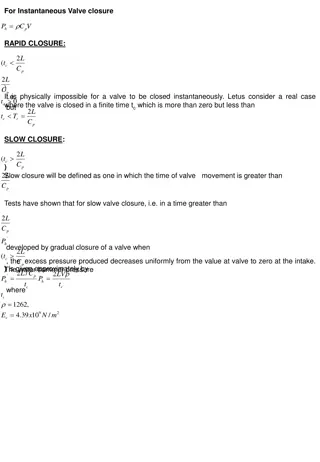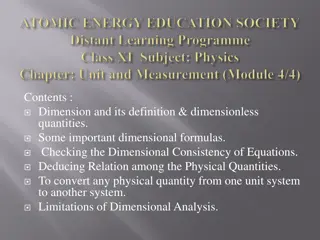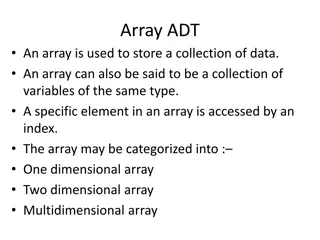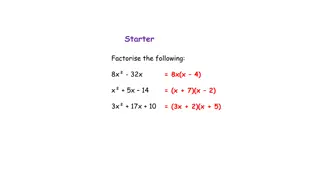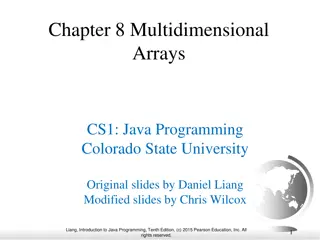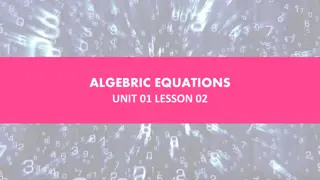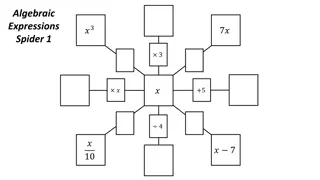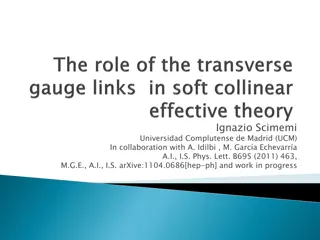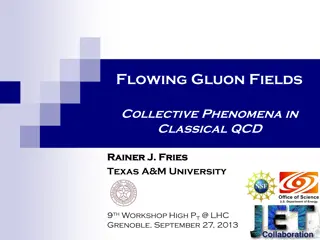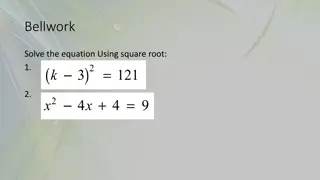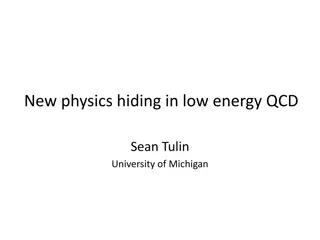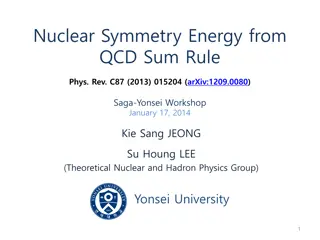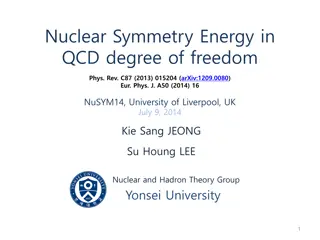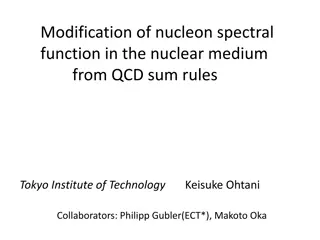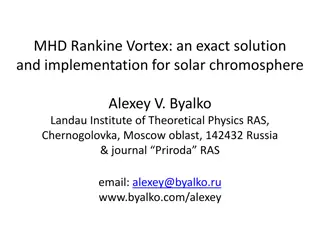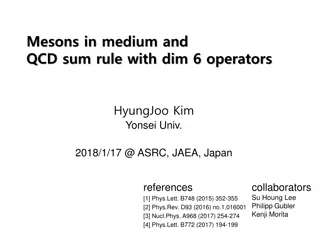Algebraic Solutions for Two-Dimensional Adjoint QCD
Two-dimensional adjoint QCD is explored with a basis-function approach aiming to achieve single-particle states over cluttered multi-particle states. The algebraic solution involves t'Hooft-like integral equations and pseudo-cyclicity considerations to address parton number violation and boundary conditions in the theory. Symmetrization techniques are employed to simplify the solution process, leading to essential outcomes for the asymptotic theory.
Download Presentation

Please find below an Image/Link to download the presentation.
The content on the website is provided AS IS for your information and personal use only. It may not be sold, licensed, or shared on other websites without obtaining consent from the author.If you encounter any issues during the download, it is possible that the publisher has removed the file from their server.
You are allowed to download the files provided on this website for personal or commercial use, subject to the condition that they are used lawfully. All files are the property of their respective owners.
The content on the website is provided AS IS for your information and personal use only. It may not be sold, licensed, or shared on other websites without obtaining consent from the author.
E N D
Presentation Transcript
Towards solving two- dimensional adjoint QCD with a basis-function approach Uwe Trittmann Otterbein University* 2017 2019 OSAPS Fall Meeting 2018, Toledo September 29, 2018 *Thanks to OSU for hospitality!
QCD2A is a 2D theory of quarks in the adjoint representation coupled by non-dynamical gluon fields ( matrix quarks ) The Problem: all known approaches are cluttered with multi-particle states (MPS) We want the bound-states, i.e. single-particle states (SPS) Get also tensor products of these SPS with relative momentum SPS interact with MPS! (kink in trajectory) DLCQ calculation shown, but typical (see Katz et al JHEP 1405 (2014) 143) Need to solve theory with new method eLCQ NPB 587(2000) PRD 66 (2002) Trouble! Group of approximate MPS
Algebraic Solution of the Asymptotic Theory I Since parton number violation is disallowed, the asymptotic theory splits into decoupled sectors of fixed parton number Wavefunctions are determined by t Hooft-like integral equations Need to fulfill boundary conditions (BCs) Pseudo-cyclicity: Hermiticity (if quarks are massive): Use sinusoidal ansatz with correct number of excitation numbers: ni; i= 1 r-1
PRD92: Algebraic Solution of the Asymptotic Theory (cont d) 3,sym(x1, x2, x3) = 3(x1,x2,x3) + 3(x2,x3,x1) + 3(x3,x1,x2) = 3(n1,n2) + 3(-n2,n1-n2) + 3(n2-n1,-n1) 3 parton WF characterized by 2 excitation numbers Adjoint t Hooft eqns are tricky to solve due to cyclic permutations of momentum fractions xi being added with alternating signs But: Simply symmetrize ansatz under C: (x1, x2, x3, xr) (x2, x3, xr ,x1) Therefore: r,sym(ni) r(ni) is an eigenfunction of the asymptotic Hamiltonian with eigenvalue 4,sym(x1, x2, x3, x4) = 4(x1,x2,x3,x4) 4(x2,x3,x4,x1) + 4(x3,x4,x1,x2) 4(x4,x1,x2,x3)
Its as simple as that and it works up to point T- T- All follows from the two-parton ( single- particle ) solution T+ T+ Can clean things up with additional symmetrization: T : bij bji Caveat: in higher parton sectors additional symmetrization is required (I said in 2015 ) Want: EF should vanish if parton momenta vanish: (0, y, z, ) = 0 So at the boundary? How to achieve that? NOT with boundary conditions! This is not a boundary condition, but the behavior of the wavefunction on a hyperplane characterized by xi=0
2017 A New Hope Idea: symmetrize the wavefunction so it does what we want at xi =0 But we need to keep it cyclic in the bulk! What if we can have the cake on one side and eat from the other? is this is this impossible? impossible?
Possible, just need some group theory and a group! What is the group, what is the symmetry? Want: EF should vanish if one or more parton momenta vanish: (0, y, z, ) = 0 Have: modular ansatz, ie a bunch of terms with different excitation numbers or frequencies: ei (nx+my+..) Unsurprisingly: ei nx e-i nx = 0 for x = 0 Solution: add/subtract partner term with negative frequencies
The Devil is in the Details Must not screw up other symmetries Must have same mass eigenvalue Not impossible: construct lower-dimensional inversion, i.e. the transformation or rather permutation of frequencies, and therefore parton momenta, so that the modified frequency safeguards the mass eigenvalue
2018 A New Symmetry Every permutation is formally an automorphism and thus a symmetry Subgroup B symmetrizes so that WFs are EFs of the Hamiltonian Subset E symmetrizes so that they vanish or are max at xi=0 Construct a complete symmetrization under lower- dimensional inversion S E of the ansatz, but: S operators do not commute S operators do not commute with T, C B Therefore left and right cosets of B are in general not the same: SiB BSi
Solution: G = B E PRD96 (2018) 045011 Symmetrize until the group is exhausted! exhaustively-symmetrized Light-Cone Quantization (eLCQ) ;-) The group of perturbations of r objects with inversions has a finite order: |G| = 2r! Can show this explicitly by constructing group in r parton sector End result: Bona fide fully symmetrized states: |TIS; n > with quantum numbers under T, I, S and r-1 excitation numbers n
Works! Massless Four-Parton Eigenfunctions Numerical (solid) vs. Algebraic (dashed) T+ (even) under string reversal (odd) T
Works! Six-Parton and Bosonic Eigenfunctions Numerical (solid) vs. Algebraic (dashed) T+ 6-parton fermionic theory Bosonized theory (adjoint fermions, (adjoint currents, 1440 terms in EFs) non-orthogonal basis)
Using the Asymptotic Basis Approximating the Full Theory Expand the full EFs into a complete set of asymptotic EFs Project onto the asymptotic EFs to get an equation for the associated coefficient Problem: In adjoint QCD we cannot use Multhopp method of 't Hooft model need to evaluate P.V. integrals numerically Ongoing work
Conclusions/ Outlook Asymptotic theory was solved algebraically in all parton sectors Coulomb (long range) problem solved! Can use complete set of solutions to solve full theory numerically with exponential convergence Can compute pair-production matrix elements which look like Can use eLCQ method to tackle other theories Certainly with adjoint degrees of freedom Possibly higher dimensions, since group structure seems independent of space-time symmetries
Thanks for your attention! Questions?
Works! Five-Parton Eigenfunctions Numerical (solid) vs. Algebraic (dashed) T- T- T- T- 2r!=240 terms in each eigenfunction! T+ T+ T+ T+ Massless theory Massive theory
Works! Massive Four-Parton Eigenfunctions Numerical (solid) vs. Algebraic (dashed) T+ (even) under string reversal (odd) T
Start with asymptotic Theory: Hasympt=Hren+HPC,s Since parton number violation is disallowed, the asymptotic theory splits into decoupled sectors of fixed parton number r =3 Wavefunctions are determined by t Hooft- like integral equations (xi are momentum fractions) r =4
Generalize: add non-singular operators Adding regular operators gives similar eigenfunctions but shifts masses dramatically Dashed lines: EFs with just singular terms (from previous slide) Here: shift by constant WF of previously massless state
